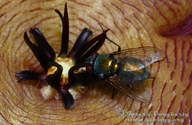|
|
click photo for larger file

Lucilia sericata
Green Bottle Fly
(shown with Stapelia hirsuta, phaenicia sericata)
|
Photographer: Joseph Dougherty
ID: 0000 0000 0509 1143 (2009-05-12)Copyright © 2009 Joseph Dougherty, M.D./ecology.org
|
|
INFORMATION PROVIDED WITH THE PHOTO
|
date of photo May 2009
location
Alameda County, California, USfamily
Calliphoridae
order
Diptera
class Insecta
notes An important pollinator of plants that use flies to move their pollinia, such as this 'Carrion Flower,' Stapelia hirsuta. The Stapelia (a commonly cultivated ornamental, native to South Africa) and its close relatives mimic the look and smell of a rotting piece of flesh, hence the faux fur and red coloration seen in many of the flowers. Those that are not red rely solely on their atrocious scent. Also a medically important insect. The following is from the Wikipedia entry for greenbottle fly: 'L. sericata has been of medical importance since 1826, when Meigen removed larvae from the eyes and facial cavities of a human patient. L. sericata has shown promise in three separate clinical approaches. First, larvae have been shown to debride wounds with extremely low probability of myiasis upon clinical application. Larval secretions have been shown to help in tissue regeneration. L. sericata have also been shown to lower bacteremia levels in patients infected with MRSA. Basically, L. sericata larvae can be used as biosurgery agents in cases where antibiotics and surgery are impractical. Studies have shown that larval secretions in vitro have been successful in enhancing fibroblast migration to wound site, positively impacting wound closure. It is found that larval therapy of L. sericata is highly recommended for the treatment of wounds infected with Gram-positive bacteria, yet is not as effective for wounds that are infected with Gram-negative bacteria. Also, studies shown that bacteria from the genus Vagococcus were resistant to the maggot excreta/secreta. Attempts are currently undergoing to extract or synthesize the chymotrypsins found in larval secretions to destroy MRSA without application of the larva itself.'camera Nikon D200, Nikkor 105mm
photo category: Animal - Invertebrate-Insect
|
MORE INFORMATION ABOUT THIS ANIMAL
|
| common names
Green Bottle Fly, Green Blowfly, Greenbottle Fly, Common Greenbottle (photographer)
View all photos in CalPhotos of Lucilia sericata Check Google Images for Lucilia sericata |
|
The photographer's identification Lucilia sericata has not been reviewed. Click here to review or comment on the identification. |
|
Using this photo The thumbnail photo (128x192 pixels) on this page may be freely used for personal or academic purposes without prior permission under the Fair Use provisions of US copyright law as long as the photo is clearly credited with © 2009 Joseph Dougherty, M.D./ecology.org.
For other uses, or if you have questions, contact Joseph Dougherty ecophotog[AT]yahoo.com. (Replace the [AT] with the @ symbol before sending an email.) |
|
|
